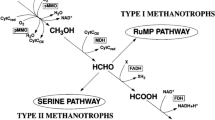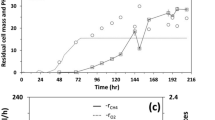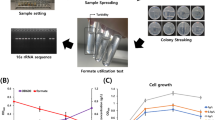Abstract
Methanogenium organophilum, a non-autotrophic methanogen able to use primary and secondary alcohols as hydrogen donors, was grown on ethanol. Per mol of methane formed, 2 mol of ethanol were oxidized to acetate. In crude extract, an NADP+-dependent alcohol dehydrogenase (ADH) with a pH optimum of about 10.0 catalyzed a rapid (5 μmol/min·mg protein; 22°C) oxidation of ethanol to acetaldehyde; after prolonged incubation also acetate was detectable. With NAD+ only 2% of the activity was observed. F420 was not reduced. The crude extract also contained F420: NADP+ oxidoreductase (0.45 μmol/min·mg protein) that was not active at the pH optimum of ADH. With added acetaldehyde no net reduction of various electron acceptors was measured. However, the acetaldehyde was dismutated to ethanol and acetate by the crude extract. The dismutation was stimulated by NADP+. These findings suggested that not only the dehydrogenation of alcohol but also of aldehyde to acid was coupled to NADP+ reduction. If the reaction was started with acetaldehyde, formed NADPH probably reduced excess aldehyde immediately to ethanol and in this way gave rise to the observed dismutation. Acetate thiokinase activity (0.11 μmol/min·mg) but no acetate kinase or phosphotransacetylase activity was observed. It is concluded that during growth on ethanol further oxidation of acetaldehyde does not occur via acetylCoA and acetyl phosphate and hence is not associated with substrate level phosphorylation. The possibility exists that oxidation of both ethanol and acetaldehyde is catalyzed by ADH. Isolation of a Methanobacterium-like strain with ethanol showed that the ability to use primary alcohols also occurs in genera other than Methanogenium.
Similar content being viewed by others
Abbreviations
- ADH:
-
alcohol dehydrogenase
- Ap5ALi3 :
-
P1,P5-Di(adenosine-5-)pentaphosphate
- DTE:
-
dithioerythritol (2,3-dihydroxy-1,4-dithiolbutane)
- F420 :
-
N-(N-l-lactyl-γ-l-glutamyl)-l-glutamic acid phosphodiester of 7,8-dimethyl-8-hydroxy-5-deazariboflavin-5′-phosphate
- Mg. :
-
Methanogenium
- OD578 :
-
optical density at 578 nm
- PIPES:
-
1,4-piperazine-diethanesulfonic acid
- TRICINE:
-
N-(2-hydroxy-1,1-bis[hydroxymethyl]methyl)-glycine
- Tris:
-
2-amino-2-hydroxy-methylpropane-1,3-diol
- U:
-
unit (μmol substrate/min)
References
Abeles RH, Lee HA (1960) The dismutation of formaldehyde by liver alcohol dehydrogenase. J Biol Chem 235:1499–1503
Balch WE, Fox GE, Magrum LJ, Woese CR, Wolfe RS (1979) Methanogens: reevaluation of a unique biological group. Microbiol Rev 43:260–296
Bradford M (1976) A rapid and sensitive method for the quantitation of microgram quantities of protein utilizing the principle of protein dye-binding. Anal Biochem 72:248–254
Bryant MP (1972) Commentary on the Hungate technique for culture of anaerobic bacteria. Am J Clin Nutr 25:1324–1328
Dalziel K, Dickinson FM (1965) Aldehyde mutase. Nature (Lond) 206:255–257
Eirich LD, Vogels GD, Wolfe RS (1978) Proposed structure for coenzyme F420 from Methanobacterium. Biochem 17:4583–4593
Fardeau ML, Belaich JP (1986) Energetics of the growth of Methanococcus thermolithotrophicus. Arch Microbiol 144:381–385
Kremer DR, Nienhuis-Kuiper HE, Hansen TA (1988) Ethanol dissimilation in Desulfovibrio. Arch Microbiol 150:552–557
Mah RA, Smith MR (1981) The methanogenic bacteria. In: Starr MP, Stolp H, Trüper HG, Balows A, Schlegel HG (eds) The prokaryotes, vol 1. Springer, New York, pp 948–977
Reynolds PE (1961) Studies on the mode of action of vancomycin. Biochim Biophys Acta 52:403–404
Schink B, Kremer DR, Hansen TA (1987) Pathway of propionate formation from ethanol in Pelobacter propionicus. Arch Microbiol 147:321–327
Schönheit P, Moll J, Thauer RK (1980) Growth parameters (K s, μmax, Y s) of Methanobacterium thermoautotrophicum. Arch Microbiol 127:59–65
Widdel F (1986) Growth of methanogenic bacteria in pure culture with 2-propanol and other alcohols as hydrogen donors. Appl Environ Microbiol 51:1056–1062
Widdel F, Wolfe RS (1989) Expression of secondary alcohol dehydrogenase in methanogenic bacteria. Purification of the F420-specific enzyme form Methanogenium thermophilum strain TCI. Arch Microbiol (in press)
Widdel F, Rouvière P, Wolfe RS (1988) Classification of secondary alcohol-utilizing methanogens including a new thermophilic isolate. Arch Microbiol 150:477–481
Zellner G, Winter J (1987) Secondary alcohols as hydrogen donors for CO2-reduction by methanogens. FEMS Microbiol Lett 44:323–328
Zellner G, Bleicher K, Braun E, Kneifel H, Tindall BJ, Conway de Macario E, Winter J (1989a) Characterization of a new mesophilic, secondary alcohol-utilizing methanogen, Methanogenium palustre spec. nov. from a peat bog. Arch Microbiol 151:1–9
Zellner G, Stackebrandt E, Messner P, Tindall BJ, Conway de macario E, Kneifel H, Sleytr UB, Winter J (1989b) Methanocorpusculaceae fam. nov., represented by Methanocorpusculum parvum, Methanocorpusculum sinense spec. nov. and Methanocorpusculum bavarium spec. nov. Arch Micorbiol 151:381–390
Author information
Authors and Affiliations
Rights and permissions
About this article
Cite this article
Frimmer, U., Widdel, F. Oxidation of ethanol by methanogenic bacteria. Arch. Microbiol. 152, 479–483 (1989). https://doi.org/10.1007/BF00446933
Received:
Accepted:
Issue Date:
DOI: https://doi.org/10.1007/BF00446933




